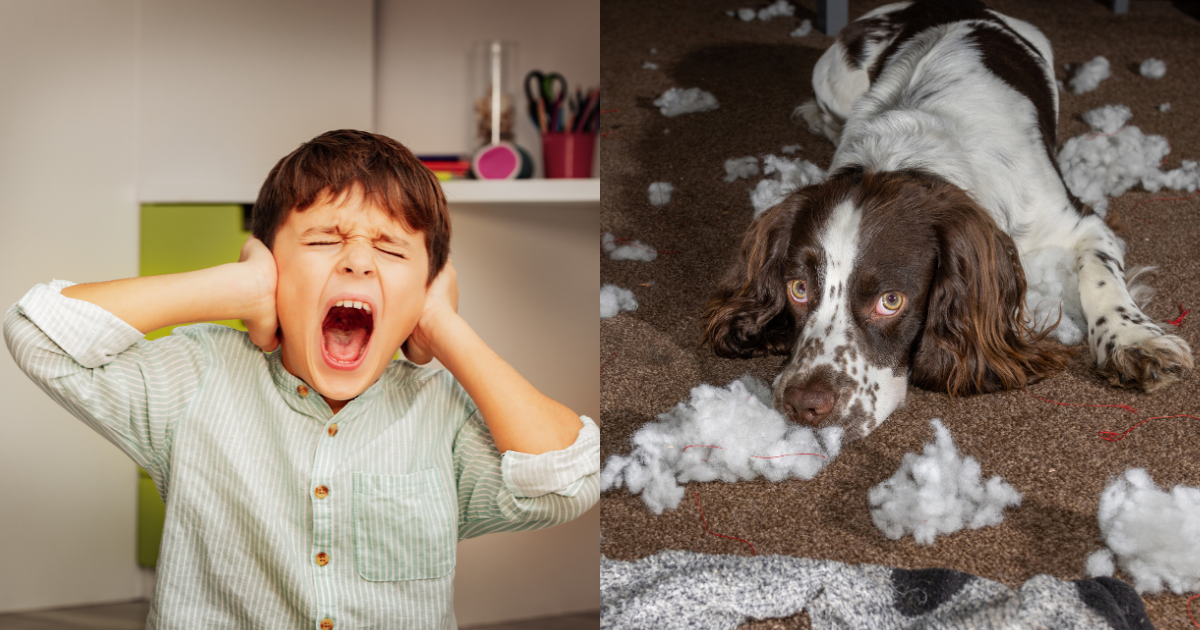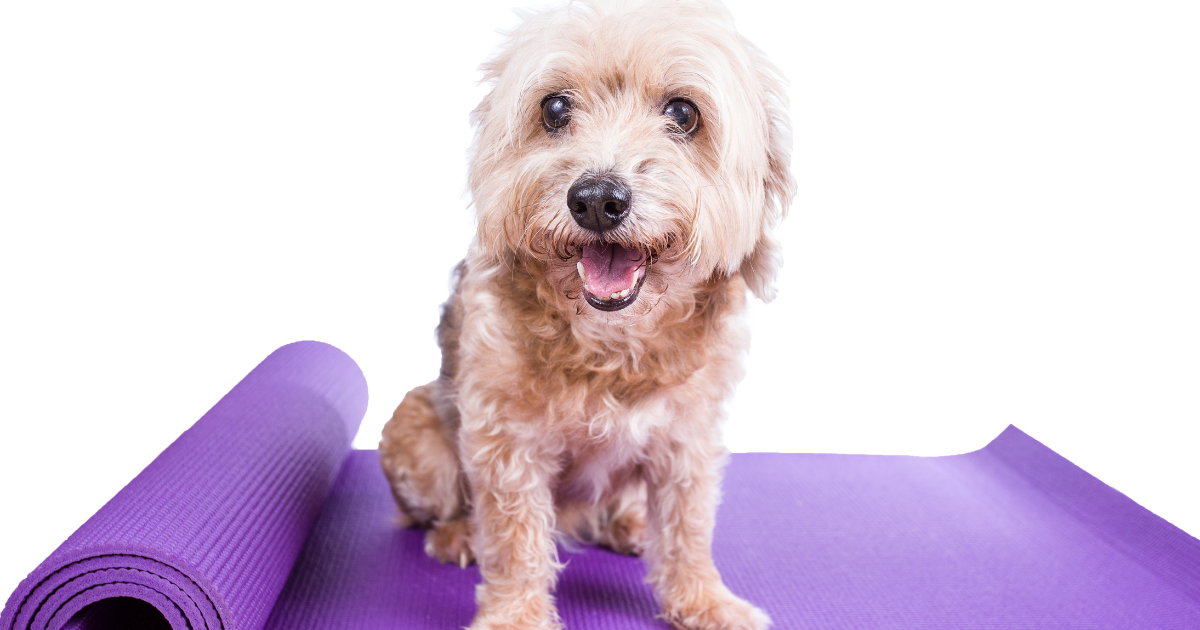We are embracing the seasons of change at Canine Brain Games Bring on the cooler weather... where we understand that dog enrichment goes beyond physical activities or toys—it’s about mental and emotional well-being, too.
One of my favorite ways to promote emotional regulation in dogs is through boundary training games. These fun games can help your dog develop a sense of calmness, impulse control, confidence, and the ability to disengage from stressful situations. So how does boundary training fit into the world of dog enrichment and how does it support emotional regulation for a well-balanced, happy dog? Keep reading and I will tell you how!
What is Emotional Regulation and Can Dogs Self-Regulate?
For over 20 years I have worked with children in the mental and behavioral health space and over 10 years with "quirky" dogs (as I call them). What does working with kids have to do with your dog?
Well, in a lot of ways, dogs learn in a similar way to young children. Dogs are not born with the ability to regulate their emotions, and just like children, they need some guidance on learning how to do so.

Children hit, bite, pull hair, and throw tantrums to get their frustrations out. We have to teach kiddos how to take a breath, walk away, and ask for help. Our dogs are not any different... You need to teach your dog how to respond during difficult times and boundary training does just that.
What is Boundary Training?
Boundary training is all about teaching your dog to stay within a specific area, such as a mat, bed, or a designated spot in the home. Think of it as your dog’s personal "doggy zen zone"—a place where they can practice self-control and relax, even when distractions are present.
My personal favorite experience with this is when my dogs know they need space and go to their "place" all on their own. THAT Is the ability to achieve emotional regulation!
Such an amazing part of impulse control training to witness.
Don't get me wrong, it doesn't happen all of the time, but can you say you regulate your emotions perfectly every time? I know I can't...

Ok, back to boundary training. This is more than just asking our dogs to "stay," boundary training is an enrichment tool that supports emotional regulation by giving your dog a safe space where your dog can learn to disengage and reset.
The Role of Boundary Training in Dog Enrichment
Dog enrichment focuses on providing activities that stimulate both the mind and body, fulfilling your dog's instincts and meeting their needs.
Boundary training fits perfectly as it taps into your dog’s need for structure, problem-solving, and choice. It’s a mentally engaging activity that challenges your dog to think, learn, and develop emotional regulation skills. This is not a way to control your dog or to be use as a form of punishment.
Here’s how boundary training enriches your dog’s emotional and mental health:
1. Promotes Calmness and Impulse Control
Boundary training through games helps teach your dog to stay calm and resist those impulsive moments, such as jumping up when the doorbell rings. By staying within their designated area, your dog practices impulse control, learning that they don’t need to react to every stimulus. Now, this does not happen immediately so playing boundary games is an important step in building up your dog impulse control. Over time, your dog will learn that the boundary means relaxation, helping them feel safe and calm even in exciting or stressful situations.
This is a key component of emotional regulation, as dogs learn to manage their reactions and maintain a state of calmness.
Remeber how I said dogs are similar to children. In order for a child to be in a state of calm, they need to feel safe. There basic needs of survival need to be met first.
2. Supports Emotional Regulation
Dogs, like humans, experience emotions such as excitement, frustration, or anxiety, which can sometimes overwhelm them... Sound familiar?
Boundary games can provide a fun way to teach emotional regulation, allowing your dog to retreat to a safe, familiar space when they need to calm down. This ability to self-soothe is so important and needed for emotional regulation, helping your dog manage stress.
3. Builds Confidence
When your dog learns that staying within their boundary, even with distractions, is a good thing they build confidence in their abilities to be around that stimulation. Similar to humans, when your dog builds their confidence, they strengthen their emotional resilience.
Confident dogs are less likely to react negatively to new or stressful situations.
Is your dog anxious or fearful? Boundary training provides a consistent, predictable space where they can feel secure, making it a great enrichment tool for confidence building.
Once your pup masters these games, you can bring a small rug or towel with you when you and your dog are out. This will give your dog a boundry during those moments when your pup needs a little extra support. I keep a lightweight dog bed in my car. This way I always have one on hand and when I know my dog needs a little help, we can use it.
4. Teaches Disengagement from Stressors
One of the most important skills your dog can learn is to disengage from stressful stimuli, whether it’s loud noises, visitors, or other distractions. Boundary training encourages your dog to step away from stressors and stay within their calm zone, allowing them to disengage and regulate their emotions. This skill helps prevent over-arousal and unwanted behaviors, such as barking or jumping, making it easier for your dog to stay calm and focused.
Integrating Boundary Training into Dog Enrichment
At Canine Brain Games, we believe in blending training with enrichment to create a more emotionally balanced dog. Our philosphy is that play is not just a pastime, it is essential. Teach new skills through play, bond through play, and meet your dogs most basic needs through play.
How To Use Boundry Games and Enrichment Together
Positive Reinforcement: Use treats and praise to reward your dog for staying within their boundary, helping them build positive associations with the space. Keep it positive and have fun with them in, on, and around their boundaries.
Increase Complexity: As your dog becomes more comfortable, introduce distractions to challenge their emotional regulation and impulse control. This will help them stay calm and focused, even in more stimulating environments.
In our October and November Brain Box, we will learn all about using a method called "Train-Test-Train" to ensure that you go at your dog's pace when teaching them a new skill.
Pair with Other Enrichment Activities: Combine boundary games with puzzle toys or scent work to keep your dog mentally engaged. This adds another layer of enrichment and reinforces their calm zone as a positive space.
Practice Daily: Consistency is key. Incorporate boundary games into your dog’s daily routine to reinforce calmness and emotional regulation, whether you’re working from home, cooking, or answering the door.
Why Dog Emotional Regulation Matters
The big question is, why dose emotional regulation and impulse control matter? When you look at your whole dog in dog training, you need to make sure you are meeting your dog's emotional well-being. Not just their ability to obey a command. I want to say that again, not just their ability to obey you. Once I really let that sink in, for me, it changed everything about my relationship with my dogs.
Helping your dog develop emotional regulation is such an important piece to a well-balanced dog. A dog that can manage their emotions is more likely to be CALM CONFIDENT EMOTIONALLY BALANCED in a variety of situations. Emotional regulation also strengthens the bond between you and your dog, as they learn to trust you to provide the support, and enrichment that meets their needs.
How Long Does It Take to See Results with Boundary Training?
This will depend on your time commitment to working with your pup and your individual dog. Keep it fun and engaging, play boundary games multiple times a day, and always remember to keep it positive.
What Specific Boundary Games Can You Play?
There are several fun and engaging boundary games you can play to help your dog develop emotional regulation, calmness, and impulse control. Here are a few ideas to get started: Go to Your Place, Mat Stay, and Release Boundary with Puzzle Toys Distraction Training Portable Boundary Game
What Should You Do if Your Dog Struggles with Boundary Training?
In Canine Brain Games, we use the Train-Test-Train method. This really helps with making sure you are going at your dog's pace, that you and your dog are not becoming frustrated, and that your dog has the foundation built before advancing to the next level.
Can Boundary Training Be Used for Dogs with Severe Behavioral Issues?
The first time I used boundary training was with my dog who, when overstimulated around other animals, goes into "seek and destroy" mode. She was also my first dog to put herself in place when she was getting overstimulated. This is one of the BEST tools you can have in your toolbox.
How Do Boundary Training and Emotional Regulation Translate to Real-Life Scenarios?
Let's take one of the most common triggers for our pup, the doorbell. Let's imagine: the doorbell rings and your dog runs to the door and starts jumping up and barking. You are then yelling at your dog and pulling them back from the door. Causing more frustration for you and your pup.
Now imagine: Your pup has learned the beautiful thing of going to their mat and knowing that you have their back and can relax while you answer the door... That is just one of the scenarios that can lead to a more relaxed dog and a more relaxed you!
Are you looking for some more tips and tricks on a more well balanced dog? Check out the Canine Brain Games Brain Box, the perfect bi-monthly dog subscription box! The only dog subscription box designed specifcally for you and your dog.
